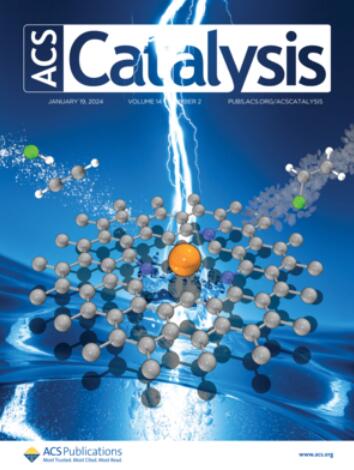Insight into Carbon Hybrid and Interfacial Modulation for High-Performance Electrosynthesis of Ethylene Glycol
IF 11.3
1区 化学
Q1 CHEMISTRY, PHYSICAL
引用次数: 0
Abstract
Electrocatalytic reduction of formaldehyde with H2O on a carbon-based catalyst has shown a promising route for ethylene glycol (EG) production; however, most of the corresponding parameters are still unsatisfactory to support industrial applications. In this work, the carbon–electrolyte interfaces by regulating carbon hybrid and introducing quaternary ammonium-based ionic liquids were investigated to improve Faradaic efficiency of EG (FEEG) with high durability at high current density (j) and low temperature. The nondefective sp2-hybridized carbon (sp2-G) was demonstrated as the main active site leading to EG. Remarkably, a high FEEG of 92.0% was thus achieved on ND-1400 at −1000 mA cm–2 with 2 wt % dodecyl trimethylammonium chloride at 50 °C. The performance remained basically unchanged within 40 h of electrolysis at −200 mA cm–2. Experimental combined theoretical studies demonstrated the formation of EG versus methanol on the sp2-G carbon is slightly disfavored in thermodynamic. However, the FEEG and the applied potential, at high j, are mainly influenced by the mass transfer of H2O while exhibiting opposite correlations. The techno-economic assessment suggested this electrosynthesis of EG is profitable at the current density as high as −400 mA cm–2 using renewable energy-based electricity in southwest China.

求助全文
约1分钟内获得全文
求助全文
来源期刊

ACS Catalysis
CHEMISTRY, PHYSICAL-
CiteScore
20.80
自引率
6.20%
发文量
1253
审稿时长
1.5 months
期刊介绍:
ACS Catalysis is an esteemed journal that publishes original research in the fields of heterogeneous catalysis, molecular catalysis, and biocatalysis. It offers broad coverage across diverse areas such as life sciences, organometallics and synthesis, photochemistry and electrochemistry, drug discovery and synthesis, materials science, environmental protection, polymer discovery and synthesis, and energy and fuels.
The scope of the journal is to showcase innovative work in various aspects of catalysis. This includes new reactions and novel synthetic approaches utilizing known catalysts, the discovery or modification of new catalysts, elucidation of catalytic mechanisms through cutting-edge investigations, practical enhancements of existing processes, as well as conceptual advances in the field. Contributions to ACS Catalysis can encompass both experimental and theoretical research focused on catalytic molecules, macromolecules, and materials that exhibit catalytic turnover.
 求助内容:
求助内容: 应助结果提醒方式:
应助结果提醒方式:


